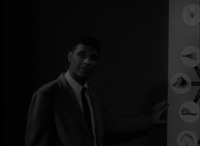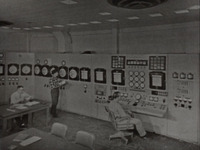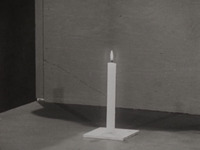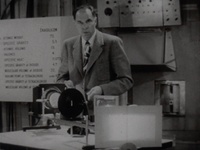Browse Exhibits (4 total)
Patterns of Life

13 episodes, 1960, University of Southern California
From WNET:
"'Patterns of life' has as its theme an explanation of the chemical bases of life, which remain constant whatever form the life itself may take. In its most simple and its most complicated forms, living matter is always based upon the same elementary chemical and physical reactions, explains Dr. Saltman: it is the purpose of this series to describe those reactions, how that are produced, and what substances go into the construction of cells and enzymes, vitamins and viruses – the elements of life. Using visual aids such as scale models, diagrams, and even rare views through electronic microscope, Dr. Saltman analyzes in layman’s terms the complicated and fascinating chemical systems which weave together into the “Patterns of Life.” The series was produced for NET by the Department of Cinema of the University of Southern California. The series consists solely of lectures and demonstrations by Dr. Saltman."
Challenge

22 episodes, 1962-1964, Ross-McElroy Productions
From WNET:
"Produced in the various laboratories of the Argonne National Laboratories in Chicago, CHALLENGE is designed to convey the excitement of scientific research. It deals in part with the motivations that lead a person toward a career in scientific research. A number of projects, including the possibilities and development of peaceful uses for the atom, are examined. Guests who appear during the series are staff members at the Argonne National Laboratories. CHALLENGE was produced for N.E.T. by Ross-McElroy Productions of Chicago. Producer: David McElroy. Director: Clifford Braun. Writers: David McElroy and John Suchy, CHALLENGE was produced under a grant from the U.S. Atomic Energy Commission’s Argonne National Laboratories."
Tempest in a test tube

26 episodes, 1957, KQED (San Francisco)
From WNET:
"'Tempest in a Test Tube' is a series of experiments in elementary chemistry. One hundred years ago, Michael Faraday, a famous British scientist, delivered a series of talks known as “Juvenile Lectures” to the teenagers of his day. A brilliant experimentalist, Faraday loved science and studied it all his life. He felt that the future science lay in the youth and he sought to share his interest with them. His talks were tremendously popular and were attended by even the children of the British Royal Family.
“Tempest in a Test Tube” is planned to carry on the tradition of Michael Faraday. The first 13 programs show that, in general, what Faraday illustrated a hundred years ago still holds true. Although this is a complex technical age with television, jet planes, atomic submarines and hydrogen bombs, the laws of science remain basic. The underlying aim of the series is to awaken an interest in chemistry and the allied sciences on the part of today’s teenager – particularly the junior high school student. The format of the programs is simple and direct: lively and colorful experiments (as many as seven per half hour) with an informal explanation of the principles involved. Continuity and the experiments were developed by a committee from the American Chemical Society."
The elements

10 episodes, 1956, KQED (San Francisco)
From WNET:
"Nobel prize winning chemist, Dr. Glenn T. Seaborg of the University of California staff, is featured on this series of 10 half-hour programs designed to raise the level of public knowledge and understanding of chemistry and its role in modern life. Working with the highly technical equipment of the UC “Cave Room” in Berkeley, Dr. Seaborg explains what an element is, how elements combine in compounds, how the 11 synthetic elements were predicted and made and how elements are distributed in the earth and in the universe. He also discusses the history of chemistry including ancient chemistry and alchemy, the Greeks’ unproved concept of the atom and isolation of the first element. Produced by KQED, San Francisco, the series features a number of other outstanding scientists as guests on various programs."

